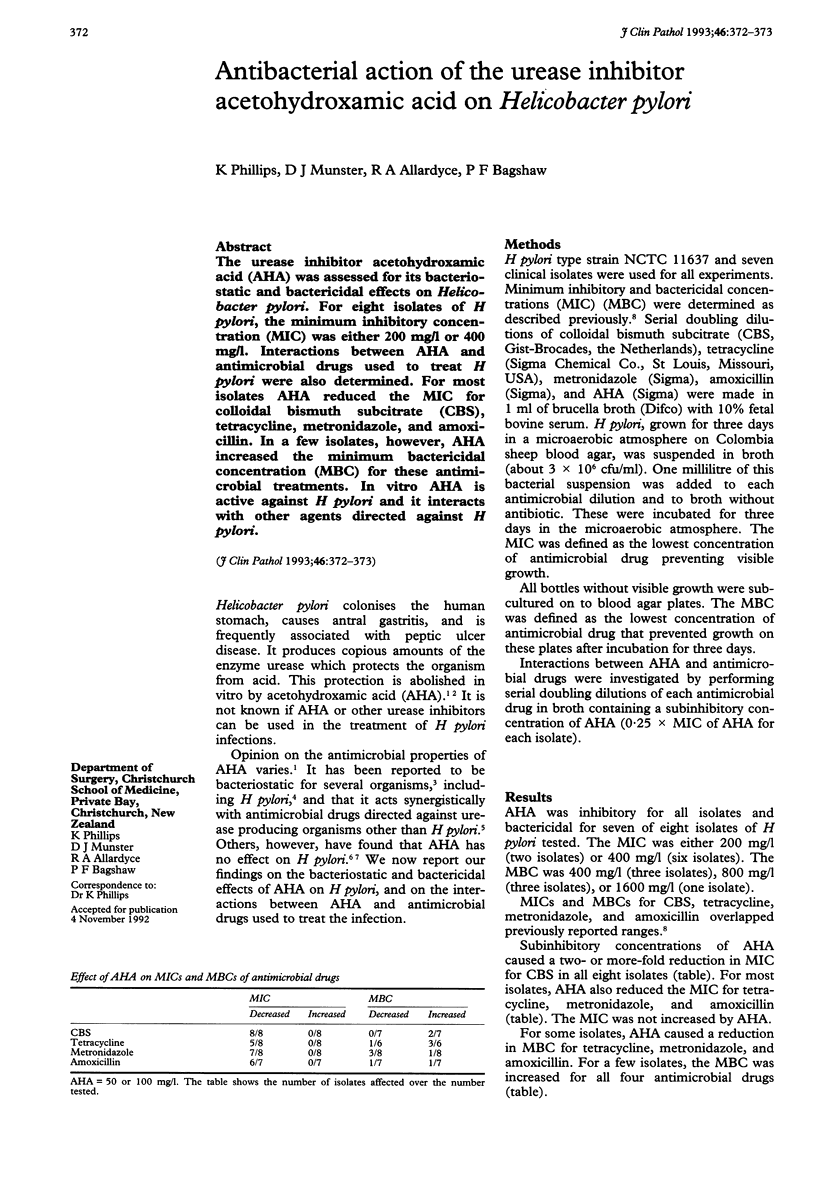Abstract
The urease inhibitor acetohydroxamic acid (AHA) was assessed for its bacteriostatic and bactericidal effects on Helicobacter pylori. For eight isolates of H pylori, the minimum inhibitory concentration (MIC) was either 200 mg/l or 400 mg/l. Interactions between AHA and antimicrobial drugs used to treat H pylori were also determined. For most isolates AHA reduced the MIC for colloidal bismuth subcitrate (CBS), tetracycline, metronidazole, and amoxicillin. In a few isolates, however, AHA increased the minimum bactericidal concentration (MBC) for these antimicrobial treatments. In vitro AHA is active against H pylori and it interacts with other agents directed against H pylori.
Full text
PDF

Selected References
These references are in PubMed. This may not be the complete list of references from this article.
- Goldie J., Veldhuyzen van Zanten S. J., Jalali S., Richardson H., Hunt R. H. Inhibition of urease activity but not growth of Helicobacter pylori by acetohydroxamic acid. J Clin Pathol. 1991 Aug;44(8):695–697. doi: 10.1136/jcp.44.8.695. [DOI] [PMC free article] [PubMed] [Google Scholar]
- Goodwin C. S., Blake P., Blincow E. The minimum inhibitory and bactericidal concentrations of antibiotics and anti-ulcer agents against Campylobacter pyloridis. J Antimicrob Chemother. 1986 Mar;17(3):309–314. doi: 10.1093/jac/17.3.309. [DOI] [PubMed] [Google Scholar]
- Griffith D. P., Musher D. M., Campbell J. W. Inhibition of bacterial urease. Invest Urol. 1973 Nov;11(3):234–238. [PubMed] [Google Scholar]
- Mobley H. L., Cortesia M. J., Rosenthal L. E., Jones B. D. Characterization of urease from Campylobacter pylori. J Clin Microbiol. 1988 May;26(5):831–836. doi: 10.1128/jcm.26.5.831-836.1988. [DOI] [PMC free article] [PubMed] [Google Scholar]
- Mooney C., Munster D. J., Bagshaw P. F., Allardyce R. A. Helicobacter pylori acid resistance. Lancet. 1990 May 19;335(8699):1232–1232. doi: 10.1016/0140-6736(90)92764-9. [DOI] [PubMed] [Google Scholar]
- Musher D. M., Saenz C., Griffith D. P. Interaction between acetohydroxamic acid and 12 antibiotics against 14 gram-negative pathogenic bacteria. Antimicrob Agents Chemother. 1974 Feb;5(2):106–110. doi: 10.1128/aac.5.2.106. [DOI] [PMC free article] [PubMed] [Google Scholar]
- Veldhuyzen van Zanten S. J., Goldie J., Hunt R. H. Inhibition of Helicobacter pylori by acetohydroxamic acid. Lancet. 1990 Dec 22;336(8730):1584–1585. doi: 10.1016/0140-6736(90)93362-s. [DOI] [PubMed] [Google Scholar]


